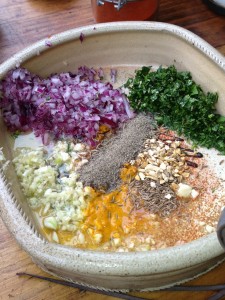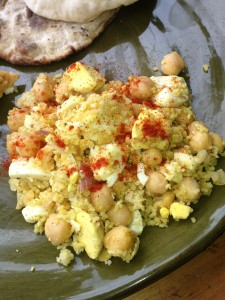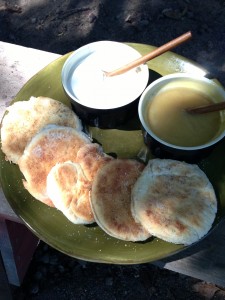This was one of our more popular shows this weekend. Tangine cooking uses a cone shaped ceramic pot that bastes the food as it cooks. For those who travel, the ceramic pots would not hold up, so cast iron pots were often used instead. We used a cast iron pot and the results were delicious.  Traditionally, lamb, goat, and camel were used in tangine cooking. We used chicken in this particular recipe.
Traditionally, lamb, goat, and camel were used in tangine cooking. We used chicken in this particular recipe.
Ingredients
6 cloves garlic, peeled and finely chopped
1 tsp ground cumin
1 tsp ground ginger
1/2 tsp sweet paprika
1 tbsp kosher or sea salt
1/2 tsp freshly ground black pepper
1 large Spanish onion, grated (about 1 cup)
2 tbsps canola, grapeseed or olive oil (not a heavy olive oil)
1 to 2 preserved lemons, depending on size
8 chicken thighs, with bone and skin
Stems from the parsley and cilantro, tied with twine
1/4 tsp powdered saffron or 1/4 tsp powdered turmeric and 4 strands saffron
1 cup pitted green Moroccan or Greek olives
1/2 bunch Italian parsley, about 1/4 cup chopped
1/2 bunch cilantro, about 1/4 cup chopped
Optional: Tomatoes and/or red peppers, coursely diced
In a large bowl, mix the garlic, cumin, ginger, paprika, salt and pepper, 1/2 cup grated onion, and the oil.
Rinse the preserved lemons, and remove the pulp. Reserve the lemon peel for later use.
Add the lemon pulp to the mixing bowl. Add the chicken. Mix everything together and place in a large plastic bag to marinate overnight in the refrigerator. (Twenty-four hours really gives the chicken the best flavor.)
In a large Dutch oven or casserole, place the chicken and marinade; add the stems of the parsley and cilantro, the rest of the grated onion, the powdered saffron and 1 1/2 cups water. Bring to a boil over high heat, turn down to a simmer and cook, partially covered, for 30 minutes.
Remove the cover, stir the chicken and continue to simmer for another 15 minutes or until the chicken is tender.
Remove the chicken to a serving dish and cover with foil to keep warm. Keep sauce on stove and begin to reduce.
Slice the preserved lemon peel into thin slices and add to the sauce along with the olives, parsley and cilantro. Reduce until the sauce is just a little thick. This shouldn’t take more than 5 minutes at most.
Uncover the chicken and remove the skin from the chicken. (It doesn’t look pretty and who needs the extra fat.) Pour sauce over chicken and serve.




